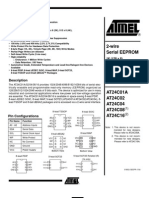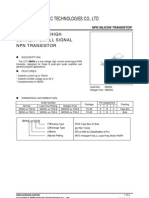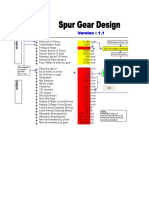Datasheet EEPROM
Datasheet EEPROM
Uploaded by
Iram Loya ValladaresCopyright:
Available Formats
Datasheet EEPROM
Datasheet EEPROM
Uploaded by
Iram Loya ValladaresOriginal Title
Copyright
Available Formats
Share this document
Did you find this document useful?
Is this content inappropriate?
Copyright:
Available Formats
Datasheet EEPROM
Datasheet EEPROM
Uploaded by
Iram Loya ValladaresCopyright:
Available Formats
CORPORAT!
ON
GP24BC01/02/02/04/08/16 Page: 1/9
ISSUED DATE :2006/08/17
REVISED DATE :
G GP P2 24 4B BC C0 01 1/ / 0 02 2/ / 0 04 4/ / 0 08 8/ / 1 16 6
2 - wi r e S e r i a l E EP ROM 1 K/ 2 K/ 4 K/ 8 K/ 1 6 K
Description
The GP24BC family provides 1K, 2K, 4K, 8K and 16K of serial electrically erasable and programmable
read-only memory (EEPROM). The wide Vdd range allows for low-voltage operation down to 1.8V. The device,
fabricated using traditional CMOS EEPROM technology, is optimized for many industrial and commercial
applications where low-voltage and low-power operation is essential. The device is accessed via a 2-wire serial
interface.
Features
Internally organized as 128x8 (1K), 256x8 (2K)
512x8 (4K), 1024x8 (8K), 2048x8 (16K),
Low-voltage and standard-voltage operation:
1.8V~5.5V
-wire serial interface bus
Date retention: 100years
High endurance: 1,000,000 Write Cycles
100KHz (1.8V) & 400KHz (5V) compatibility
Bi-directional data transfer protocol
Self-timed write cycle (5ms max)
Write protect pin for hardware data protection
8-byte page (1K, 2K) and 16-byte page (4K,8K,16K)
write modes
Allows for partial page write
Package Dimensions
Millimeter Millimeter
REF.
Min. Max.
REF.
Min. Max.
A - 0.5334 c1 0.203 0.279
A1 0.381 - D 9.017 10.16
A2 2.921 4.953 E 6.096 7.112
b 0.356 0.559 E1 7.620 8.255
b1 0.356 0.508 e 2.540 BSC
b2 1.143 1.778 HE - 10.92
b3 0.762 1.143 L 2.921 3.810
c 0.203 0.356
Figure 1. Pin Configurations
Pin Name Function
A0 A2 Address inputs
SDA Serial Data
SCL Serial Clock Input
WP Write Protect
Gnd Ground
Vcc Power Supply
Absolute Maximum Ratings
Parameter Ratings Unit
Voltage on Any Pin with Respect to Ground -0.8 to Vcc +1.5 V
Maximum Operating Voltage 6.25 V
DC Output Current 5.0 mA
Operating Temperature Range -55 ~ +125
Storage Temperature Range -65 ~ +150
Note: Stresses beyond those listed under Absolute Maximum Ratings may cause permanent damage to the device. This is a stress
rating only and functional operation of the device at these or any other conditions beyond those indicated in the operational sections of
these specifications are not implied. Exposure to absolute maximum rating conditions for extended periods may affect device reliability.
L
A
SEATING PLANE
e b
Z Z
E
D
c
SECTION Z - Z
b
GAUGE PLANE
DIP-8
CORPORAT!ON
GP24BC01/02/02/04/08/16 Page: 2/9
ISSUED DATE :2006/08/17
REVISED DATE :
Figure 2. Block Diagram
PIN Descriptions
Serial Data (SDA): The SDA pin used for sending and receiving data bits in serial mode. Since the SDA pin is
defined as an open-drain connection, a pull-up resistor is needed.
Serial Clock (SCL): The SCL input is used to synchronize data input and output with the clocked out on the
falling edge of SCL.
Device/Page Addresses (A2, A1, A0): The A2, A1, and A0 pins are used to address multiple devices on a
single bus system and should be hard-wired.
The GP24BC01 and GP24BC02 use the A2, A1 and A0 pins to provide the capability for addressing up to
eight 1K/2K devices on a single bus system (please see the Device Addressing section for further details)
The GP24BC04 uses the A2 and A1 inputs and a total of for 4K device may be addressed on a single bus
system. The A0 pin in not used, but should be grounded if possible.
The GP24BC08 only uses the A2 input hardwire addressing. On a single bus system, a total of two 8K
devices may be addressed. The A0 and A1 pins are not used, but should be grounded if possible.
The GP24BC16 does not uses the device address pins, so only one device can be connected to a single
bus system. Therefore, the A0, A1 and A2 pins are not used, but should be grounded if possible.
Write Protect (WP): The GP24BC01/02/04/08/16 has a Write Protect pin that provides hardware data
protection. When connected to ground, the Write Protect pin allows for normal read/write operations. If the WP
pin is connected to VCC, no data can be overwritten.
CORPORAT!ON
GP24BC01/02/02/04/08/16 Page: 3/9
ISSUED DATE :2006/08/17
REVISED DATE :
Memory Organization
The internal memory organization for the GP24BC family is arranged differently for each of the densities. The
GP24BC01, for instance, is internally organized as 16 pages of 8 bytes each and requires a 7-bit data word
address. The GP24BC16, on the other hand, is organized as 128 pages of 16 bytes each with an 11-bit data
word address. The table below summarizes these differences.
Density # of pages Bytes per page Data word address length
GP24BC01 (1K) 16 pages 8 bytes 7 bits
GP24BC02 (2K) 32 pages 8 bytes 8 bits
GP24BC04 (4K) 32 pages 16 bytes 9 bits
GP24BC08 (8K) 64 pages 16 bytes 10 bits
GP24BC16 (16K) 128 pages 16 bytes 11 bits
PIN Capacitance
Applicable over recommended operating range from TA=25, f=1.0MHz, Vcc=+1.8V
Symbol Test Condition Max Unit Condition
CI/O Input/Output Capacitance (SDA) 8 pF VI/O=0V
CIN Input Capacitance (A0, A1, A2, SCL) 6 pF VIN=0V
Note: 1.This parameter is characterized and not 100% tested.
DC Characteristics
Applicable over recommended operating range from: TA=-40 ~ +85, VCC=+1.8 ~ +5V (unless otherwise noted)
Parameter Symbol Test Condition Min TYP Max Unit
Supply Voltage VCC1 1.8 - 5.5 V
Supply Voltage VCC2 2.7 - 5.5 V
Supply Voltage VCC3 4.5 - 5.5 V
Supply Current VCC=5.0V ICC READ at 100KHz - 0.4 1.0 mA
Supply Current VCC=5.0V ICC WRITE at 100KHz - 2.0 3.0 mA
Standby Current VCC=1.8V ISB1 VIN= VCC or VSS - 0.6 3.0 A
Standby Current VCC=2.5V ISB2 VIN= VCC or VSS - 1.4 4.0 A
Standby Current VCC=5.5V ISB3 VIN= VCC or VSS - 5.0 18 A
Input Leakage Current ILI VIN= VCC or VSS - 0.2 5.0 A
Output Leakage Current ILO VOUT= VCC or VSS - 0.1 5.0 A
Input Low Level
(1)
VIL -0.6 - VCCx0.3 V
Input High Level
(1)
VIH VCCx0.7 - VCC+0.5 V
Output Low Level VCC=3.0V VOL2 IOL=2.1mA - - 0.4 V
Output Low Level VCC=3.0V VOL1 IOL=0.15mA - - 0.2 V
Note 1: VIL and VIH max are reference only and are not tested.
CORPORAT!ON
GP24BC01/02/02/04/08/16 Page: 4/9
ISSUED DATE :2006/08/17
REVISED DATE :
AC Characteristics Applicable over recommended operating range from: TA=-40 ~ +85,
VCC=+1.8 ~ 5.5V, CL=1 TTL Gate & 100pF (unless otherwise noted)
Parameter Symbol Test Condition Min TYP Max Unit
Clock Frequency, SCL fSCL
VCC=1.8V
VCC=2.7 ~ 5.5V
- -
100
400
KHz
Clock Pulse Width Low tLOW
VCC=1.8V
VCC=2.7 ~ 5.5V
4.7
1.2
- - s
Clock Pulse Width High tHIGH
VCC=1.8V
VCC=2.7 ~ 5.5V
4.0
0.6
- - s
Noise Suppression Time (1) tI
VCC=1.8V
VCC=2.7 ~ 5.5V
- -
100
50
ns
Clock Low to Data Out Valid tAA
VCC=1.8V
VCC=2.7 ~ 5.5V
0.1
0.1
-
4.5
0.9
s
Time the bus must be free before
a new transmission can start (1)
tBUF
VCC=1.8V
VCC=2.7 ~ 5.5V
4.7
1.2
- - s
Start Hold Time tHD.STA
VCC=1.8V
VCC=2.7 ~ 5.5V
4.0
0.6
- - s
Start Setup Time tSU.STA
VCC=1.8V
VCC=2.7 ~ 5.5V
4.7
0.6
- - s
Data in Hold Time tHD.DAT
VCC=1.8V
VCC=2.7 ~ 5.5V
0
0
- - s
Data in Setup Time tUS.DAT
VCC=1.8V
VCC=2.7 ~ 5.5V
200
100
- - ns
Input Rise Time (1) tR
VCC=1.8V
VCC=2.7 ~ 5.5V
- -
1.0
0.3
s
Input Fall Time (1) tF
VCC=1.8V
VCC=2.7 ~ 5.5V
- -
300
300
ns
Stop Setup Time tSU.STO
VCC=1.8V
VCC=2.7 ~ 5.5V
4.7
0.6
- - s
Data Out Hold Time tDH
VCC=1.8V
VCC=2.7 ~ 5.5V
100
50
- - ns
Write Cycle Time tWR
VCC=1.8V
VCC=2.7 ~ 5.5V
- -
5
5
ms
5.0V, 25, Byte Mode
Endurance
(1)
VCC=1.8V
VCC=2.7 ~ 5.5V
1M
1M
- -
Write
Cycles
Note: 1. This parameter is characterized and not 100% tested.
Device Operation
Clock and Data Transitions: Transitions on the SDA pin should only occur when SCL is low (refer to the Data
Validity timing diagram in Figure 5). If the SDA pin changes when SCL is high, then the transition will be
interpreted as a START or STOP condition.
START Condition: A START condition occurs when the SDA transitions form high to low when SCL is high.
The START signal is usually used to initiate a command (refer to the Start and Stop Definition timing diagram in
Figure 6).
STOP Condition: A STOP condition occurs when the SDA transitions form low to high when SCL is high (refer
to Figure 6. START and STOP Definition timing diagram). The STOP command will put the device into standby
mode after no acknowledgment is issued during the read sequence.
Acknowledge: An acknowledgement is sent by pulling the SDA low to confirm that a word has been
successfully received. All addresses and data words are serially transmitted to and from the EEPROM in 8-bit
words, so acknowledgments are usually issued during the 9
th
clock cycle.
Standby Mode: Standby mode is entered when the chip is initially powered-on or after a STOP command has
been issued and any internal operations have been completed. .
Memory Reset: In the event of unexpected power or connection loss, a START condition can be issued to
restart the input command sequence. If the device is currently in write cycle mode, this command will be
ignored.
CORPORAT!ON
GP24BC01/02/02/04/08/16 Page: 5/9
ISSUED DATE :2006/08/17
REVISED DATE :
BUS TIMING
Figure 3. SCL: Serial Clock, SDA: Serial Data I/O
WRITE CYCLE TIMING
Figure 4. SCL: Serial Clock, SDA: Serial Data I/O
Note: 1.The write cycle time tWR is the time from a valid stop condition of a write sequence to the end of the internal
clear/write cycle
Figure 5. DATA VALIDITY
CORPORAT!ON
GP24BC01/02/02/04/08/16 Page: 6/9
ISSUED DATE :2006/08/17
REVISED DATE :
Figure 6. START & STOP DEFINITION
Figure 7. Output ACKNOWLEDGE
Device Addressing
To enable the chip for a read or write operation, an 8-bit device address word followed by a START condition
must be issued. The 1
st
four bits of the device address word consists of a mandatory 1010 pattern, while the
2
nd
four bits depend on the particular density being used (refer to Figure 8):
In the 1K/2K chip, the next 3 bits should correspond to the hard-wired input A2, A1 and A0 device address
bits.
In the 4K chip, the next 3 bits are the A2 and A1 device address bits and a memory page address bit. The
two device address bits must compare to their corresponding hard-wired input pins.
In the 8K chip, the next 3 bits include the A2 device address bits with the next 2 bits used for memory
page addressing. The A2 bit must compare to its corresponding hard-wired input pin.
In the 16K chip does not use any device address bits but instead the 3 bits are used for memory page
addressing.
Figure 8. Device Address
The memory page address bits, P2, P1 and P0 are used to select the page in the array. P2 represents the
most significant bit, while P1 and P0 are considered the next most significant bits.
The eight bit of the device address determines read or write operation. If the R/W bit is high, then a read
operation is initiated. Otherwise, if the R/W bit is low, then a write operation is started.
After comparing the device address and finding a match, the EEPROM device will issue an acknowledgment
by pulling SDA low. If the comparison fails, the chip will return to standby mode.
CORPORAT!ON
GP24BC01/02/02/04/08/16 Page: 7/9
ISSUED DATE :2006/08/17
REVISED DATE :
Figure 9. Byte Write
Figure 10. Page Write
( * = DONT CARE bit for 1K)
Write Operations
Byte/Page Write:
If a write operation is entered (R/W=0) and an acknowledgment is sent, then the next sequence requires an
8-bit data word address. After an acknowledgment is received from this word address, the 1
st
byte of data can
be loaded. The device will send an acknowledgment after each byte to confirm the transmission.
To being the write cycle, a STOP condition must be issued (refer to Figure 9). Both byte and page write
operations are supported, so the STOP condition can be issued after the 1
st
byte or the last byte in the page.
When the STOP condition occurs, an internal time is started, all input are disabled, and the EEPROM will not
respond to any more commands until the write cycle is completed.
Note: The number of bytes in a page depends on the density used. If 1K density is used, then the page size is
8 bytes. In contrast, if the 16K density is used, then the page size is 16 bites. Refer to the Memory
Organization section for more details.
The internal page counter is incremented after each byte received, but the row location of the memory page
will always remain the same. Therefore, the device will wrap around to the 1
st
byte in the page after the last
byte in the page is received. Any further data loaded into the page buffer will overwrite the previous data
loaded.
Acknowledge Polling: After the STOP condition is issued, the write cycle begins. Acknowledge polling can be
initiated by sending a START condition followed by the device address word. If the EEPROM has completed
the internal write cycle and returned to standby mode, the device will respond by sending back an
acknowledgment by pulling the SDA pin low. Otherwise, the sequence will be ignored and no acknowledgment
will be sent.
Read Operations
There are three types of read operations: current address read, random address read, and sequence read. A
random address read can be considered a current address read operation with an additional sequence in the
beginning to load a different address into the internal counter. A sequential read occurs when subsequent
bytes are clocked out after a current address read or random address read occurs.
*
*
CORPORAT!ON
GP24BC01/02/02/04/08/16 Page: 8/9
ISSUED DATE :2006/08/17
REVISED DATE :
Current Address Read: A current address read operation is initiated by issuing R/W=1 in the device address
word (refer to Figure 11). Since the internal address counter maintains the last address incremented by one
accessed during the last read or write operation, the internal address counter will always retain the last
address incremented by one.
Random Read: To access a different address location that the one currently stored in the internal counter, a
random read operation is provided. The random read is actually a combination of a dummy byte write
sequence with a current address read command (refer to Figure 12). The dummy byte write loads a different
address into the internal counter, and the data can then be accessed using the current address read.
Sequential Read: In order to access subsequent data word after a current address read or random read has
been initiated, the user should send an acknowledgment to the EEPROM chip after each data byte received. If
an acknowledgment is not received, then the chip will not send any more data and expect a STOP condition on
the next cycle to reset back to standby more (refer to Figure 13).
Sequential reads can be used to perform an entire chip read. Unlike the page write operation, the internal
counter will increment to the next row after the last byte of the page has been reached. When the address
reaches the last byte of the last memory page, the next address will increment to the 1
st
byte of the 1
st
memory
page.
Once the memory address limit is reached, the data word address will roll over and the sequential read will
continue. When the microcontroller does not respond with a zero but does generate a following stop condition,
the sequential read operations is terminated.
Figure 11. Current Address Read
Figure 12. Random Read
( * = DONT CARE bit for 1K)
Figure 13. Sequential Read
*
CORPORAT!ON
GP24BC01/02/02/04/08/16 Page: 9/9
ISSUED DATE :2006/08/17
REVISED DATE :
GP24BC Ordering Information
Ordering Code Package Operating Ranges
GP24BC01I
GP24BC02I
GP24BC04I
GP24BC08I
GP24BC16I
DIP-8 Industrial (-40 ~ +85 )
Product Ordering Information
GP24BCXXY
Important Notice:
All rights are reserved. Reproduction in whole or in part is prohibited without the prior written approval of GTM.
GTM reserves the right to make changes to its products without notice.
GTM semiconductor products are not warranted to be suitable for use in life-support Applications, or systems.
GTM assumes no liability for any consequence of customer product design, infringement of patents, or application assistance.
Head Office And Factory:
Taiwan: No. 17-1 Tatung Rd. Fu Kou Hsin-Chu Industrial Park, Hsin-Chu, Taiwan, R. O. C.
TEL : 886-3-597-7061 FAX : 886-3-597-9220, 597-0785
China: (201203) No.255, Jang-Jiang Tsai-Lueng RD. , Pu-Dung-Hsin District, Shang-Hai City, China
TEL : 86-21-5895-7671 ~ 4 FAX : 86-21-38950165
P=DIP-8
G=GTM
24=Device Type
Supply Voltage
BC=1.8V to 5.5V
Device Function
01= 1 Kbit (128x8)
02= 2 Kbit (256x8)
04= 4 Kbit (512x8)
08= 8 Kbit (1024x8)
16=16 Kbit (2048x8)
Temperature
I=Industrial (-40 ~ +85
You might also like
- DUCATI Bikes DumptoolsDocument12 pagesDUCATI Bikes DumptoolsOleh PoNo ratings yet
- FIS Module ProgrammerDocument6 pagesFIS Module ProgrammerFer Nando100% (1)
- La-3961p JFW01Document48 pagesLa-3961p JFW01Misael Souza100% (1)
- 2-Wire Serial EEPROM: FeaturesDocument23 pages2-Wire Serial EEPROM: FeaturesgillupilluNo ratings yet
- Technical Service BulletinDocument9 pagesTechnical Service BulletinMultiAbderrahmaneNo ratings yet
- Et STM32F103Document25 pagesEt STM32F103priyosantosaNo ratings yet
- What Are The Pinout and Pin Functions of The Openport 2.0Document2 pagesWhat Are The Pinout and Pin Functions of The Openport 2.0spalomosNo ratings yet
- CY310 Product InfoDocument2 pagesCY310 Product InfoAnonymous xTGQYFrNo ratings yet
- Introduction To Reading An EEPROM: OscillatorDocument5 pagesIntroduction To Reading An EEPROM: OscillatorJorge Antonio Guillen100% (1)
- Multi AirsystemDocument13 pagesMulti AirsystemSivaji Liar100% (1)
- Tms 374 Decodeur EcuDocument5 pagesTms 374 Decodeur EcuAnonymous 4IEjocNo ratings yet
- CARPROG CR16 Airbag ManualDocument9 pagesCARPROG CR16 Airbag ManualJorge Antonio GuillenNo ratings yet
- MERCEDES 722.6: Ause OmplaintDocument1 pageMERCEDES 722.6: Ause OmplaintVjollcaCuciNo ratings yet
- ECT and A/T Indicator, Engine ControlDocument19 pagesECT and A/T Indicator, Engine ControlAdin VifaldhiNo ratings yet
- Basic Concepts in Serial I/O Interfacing I/O DevicesDocument33 pagesBasic Concepts in Serial I/O Interfacing I/O DevicessubendNo ratings yet
- Sfi System: PrecautionDocument60 pagesSfi System: PrecautionChristian Linares AbreuNo ratings yet
- EcuTek User GuideDocument18 pagesEcuTek User Guiderumellemur59No ratings yet
- Can Bus Svel 02Document121 pagesCan Bus Svel 02Ahmad Bik ElhaysNo ratings yet
- Haltech Sport 1000 Mazda rx7Document20 pagesHaltech Sport 1000 Mazda rx7Henry WorkshopNo ratings yet
- Check Engine LightDocument9 pagesCheck Engine LightJulio CésarNo ratings yet
- Manual Transmission and Differential (Diagnostics)Document38 pagesManual Transmission and Differential (Diagnostics)GURBZHNo ratings yet
- 93c56 DatasheetDocument15 pages93c56 DatasheetsakerhetfreakNo ratings yet
- Service Manual: History Information For The Following ManualDocument34 pagesService Manual: History Information For The Following ManualHamza AbbasiNo ratings yet
- Sensors OxygenDocument1 pageSensors Oxygenkatwat100% (1)
- "LCD Device Driver" For Reconfigurable Instrument ClusterDocument6 pages"LCD Device Driver" For Reconfigurable Instrument ClustersrikanthshenoyNo ratings yet
- Wiring Diagrams: Identification Component Location MenuDocument13 pagesWiring Diagrams: Identification Component Location MenuToua Yaj100% (1)
- DTC B2799 (Engine Immobilizer System) - Lexux IS 250 - 2007Document4 pagesDTC B2799 (Engine Immobilizer System) - Lexux IS 250 - 2007YusleiviNo ratings yet
- 10-6620 For EMS - 30-6620Document14 pages10-6620 For EMS - 30-6620Michael AliNo ratings yet
- DIAGNOSIC SYSTEMlDocument2 pagesDIAGNOSIC SYSTEMlDhammikaNo ratings yet
- ChipsDocument3 pagesChipsTony AlecsaNo ratings yet
- EEPROMDocument4 pagesEEPROMJuan Guillermo MansillaNo ratings yet
- 1996 850 Wiring DiagramDocument238 pages1996 850 Wiring DiagramwilderNo ratings yet
- ECUTEST Supported Vehicle ListDocument32 pagesECUTEST Supported Vehicle ListIcNo ratings yet
- 2zz Ge EngineDocument20 pages2zz Ge Enginestevo1500No ratings yet
- Car BaseDocument90 pagesCar BaseJUANNo ratings yet
- VVDI Prog User Manual V4.9.9Document70 pagesVVDI Prog User Manual V4.9.9Hemilton Abreu100% (2)
- V850ESDocument6 pagesV850ESVictor Ramalho50% (2)
- How Volvo Turbo Systems WorkDocument5 pagesHow Volvo Turbo Systems Worksaifrul100% (1)
- Engine Immobiliser System (LHD W/O Smart Key System) : 244 LS430 (EWD435F) LS430 (EWD435F) 245Document1 pageEngine Immobiliser System (LHD W/O Smart Key System) : 244 LS430 (EWD435F) LS430 (EWD435F) 245Tomy100% (1)
- 722 600 PDFDocument6 pages722 600 PDFAdonis Reyes VillegasNo ratings yet
- Nag1 21-2Document829 pagesNag1 21-2Jorge Arturo100% (1)
- VVT GeelyDocument6 pagesVVT GeelydokarusNo ratings yet
- Remove - Install Intelligent Servo ModuleDocument3 pagesRemove - Install Intelligent Servo ModuleJosephNo ratings yet
- E38 Immobiliser System EWS3Document4 pagesE38 Immobiliser System EWS3naamikekwekuaduNo ratings yet
- Control System Control System Schematic BtraDocument52 pagesControl System Control System Schematic BtraRoe De HardtoknowNo ratings yet
- CAN (Controller Area Network) : CAN System Diagram (RX330)Document7 pagesCAN (Controller Area Network) : CAN System Diagram (RX330)JoelNo ratings yet
- Hualingan Model List 2014Document12 pagesHualingan Model List 2014talita fernanda pontes castelloNo ratings yet
- A274 Aldl ProtocolDocument13 pagesA274 Aldl ProtocolJonathonThompsonNo ratings yet
- Can Communication Codes GuidelinesDocument12 pagesCan Communication Codes GuidelinesAlfonso AlfonsoNo ratings yet
- Autoscan Grason WAUZZZ8E32A120922 227730km 141504miDocument3 pagesAutoscan Grason WAUZZZ8E32A120922 227730km 141504miVoicu FlorinNo ratings yet
- Kdfi V1.4: User Manual (English)Document13 pagesKdfi V1.4: User Manual (English)Dot3xe Nicolas100% (1)
- FUEL SYSTEM (2AZ FE) (From July, 2003) : PrecautionDocument56 pagesFUEL SYSTEM (2AZ FE) (From July, 2003) : PrecautionSendi IndartoNo ratings yet
- Diagnostic Trouble Code ChartDocument5 pagesDiagnostic Trouble Code ChartGregory Ashley100% (1)
- Discovering the Toyota Prius Hybrid: Your Easy Guide to Eco-Friendly DrivingFrom EverandDiscovering the Toyota Prius Hybrid: Your Easy Guide to Eco-Friendly DrivingNo ratings yet
- 2-Wire Serial EEPROM: FeaturesDocument26 pages2-Wire Serial EEPROM: FeaturesLinkyNo ratings yet
- Atmel 24C02Document24 pagesAtmel 24C02chichedemorenoNo ratings yet
- Two-Wire Serial EEPROM: FeaturesDocument28 pagesTwo-Wire Serial EEPROM: FeaturesdobsrdjanNo ratings yet
- 24 LC 2561Document12 pages24 LC 2561ricardo_MassisNo ratings yet
- Two-Wire Automotive Temperature Serial EEPROM: FeaturesDocument20 pagesTwo-Wire Automotive Temperature Serial EEPROM: Features강종운No ratings yet
- AtmelDocument19 pagesAtmelRobinHútNo ratings yet
- Atmel 8568 SEEPROM AT24C256C Datasheet PDFDocument21 pagesAtmel 8568 SEEPROM AT24C256C Datasheet PDFhanifNo ratings yet
- Electric Chain Hoist: Operator'S ManualDocument24 pagesElectric Chain Hoist: Operator'S ManualFMU KSANo ratings yet
- Unisonic Technologies Co., LTD: Low Voltage High Current Small Signal NPN TransistorDocument4 pagesUnisonic Technologies Co., LTD: Low Voltage High Current Small Signal NPN TransistorproctepNo ratings yet
- Bi0068130001 - Manual de PartesDocument677 pagesBi0068130001 - Manual de PartesMiguel angel Guerra Briceño100% (1)
- 13.5.3 Example Simulation Codes: Temperature Sensors: Is It Hot in Here, or Is It Just Me?Document5 pages13.5.3 Example Simulation Codes: Temperature Sensors: Is It Hot in Here, or Is It Just Me?ali alilouNo ratings yet
- 300+ TOP Measurement & Instrumentation NTS MCQs and Answers 2022Document36 pages300+ TOP Measurement & Instrumentation NTS MCQs and Answers 2022Humsafer ALiNo ratings yet
- MELSEC-Q Series To IQ-R MigrationDocument406 pagesMELSEC-Q Series To IQ-R Migrationmc4431No ratings yet
- 6611c 用户手册 PDFDocument76 pages6611c 用户手册 PDFOYDWNo ratings yet
- 2010 11 001 001 enDocument104 pages2010 11 001 001 enJulio Meza100% (1)
- Service Manual: LC320EM81Document69 pagesService Manual: LC320EM81wilfredo falconNo ratings yet
- MTUDocument115 pagesMTUrinho2013100% (2)
- Fuji Ups 7700fDocument9 pagesFuji Ups 7700fschauhan12No ratings yet
- Imagen Termica DigitalDocument46 pagesImagen Termica DigitalDaniel SubelzaNo ratings yet
- Preservation Inspection Checklist-804196Document1 pagePreservation Inspection Checklist-804196Bayu SaputraNo ratings yet
- Hoja de Datos PasivosDocument2 pagesHoja de Datos PasivosAndres Hernandez BolañosNo ratings yet
- Spur GearDocument3 pagesSpur Gearigualdi53No ratings yet
- CL NG 6460 0002 018 Checklist For Oil Immersed Transformer Rev00Document9 pagesCL NG 6460 0002 018 Checklist For Oil Immersed Transformer Rev00MohamedElmahdyNo ratings yet
- Ficha Tecnica Vibrocompactador Amman Ars122Document2 pagesFicha Tecnica Vibrocompactador Amman Ars122ILSENo ratings yet
- Aiwa nsx-bl14Document37 pagesAiwa nsx-bl14Rosselino DE Jesus MonteiroNo ratings yet
- RCBII RSL Parameters - 4767764251226047386845665916 PDFDocument67 pagesRCBII RSL Parameters - 4767764251226047386845665916 PDFBartz Santos50% (2)
- Difference Between Software, Embedded Software and FirmwareDocument2 pagesDifference Between Software, Embedded Software and FirmwarejjjNo ratings yet
- Dieu Khien Smartgen - HGM6110,6120 (EN)Document5 pagesDieu Khien Smartgen - HGM6110,6120 (EN)khanh khanhNo ratings yet
- Power Unit Type "T-3010 En"Document1 pagePower Unit Type "T-3010 En"Anton LyakhovNo ratings yet
- User Manual Becasmart BHT-006GCLWDocument2 pagesUser Manual Becasmart BHT-006GCLWTamo NekoNo ratings yet
- BOQ Sipil GI 150 KV TarjunDocument5 pagesBOQ Sipil GI 150 KV TarjunMarketing MptNo ratings yet
- Conventional Ram BOP TrainingDocument60 pagesConventional Ram BOP Trainingproabbey100% (1)
- KARTIKDocument20 pagesKARTIKkartikNo ratings yet
- BPXN Lock Mandrel Brio Tech Catalog Revised 1.01 S 63Document1 pageBPXN Lock Mandrel Brio Tech Catalog Revised 1.01 S 63Franklin de Jesus NavarroNo ratings yet
- Manual Motobomba LoncinDocument37 pagesManual Motobomba LoncinPrevenca Araya100% (1)
- VSP Architecture Overview V2 2Document25 pagesVSP Architecture Overview V2 2deniz isikNo ratings yet

























































































